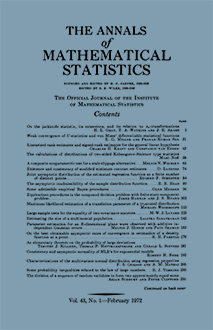Abstract
Let $X = \cdot b_1b_2b_3 \cdots$ be a random variable with independent binary digits $b_n$ taking values 0 or 1 with probability $p_n$ and $q_n = 1 - p_n$. When does $X$ have a density? A continuous density? A singular distribution? This note gives necessary and sufficient conditions for the distribution of $X$ to be: discrete: $\Sigma\min (p_n, q_n) < \infty$; singular: $\Sigma^\infty_m\lbrack\log (p_n/q_n)\rbrack^2 = \infty$ for every $m$; absolutely continuous: $\Sigma^\infty_m\lbrack\log (p_n/q_n)\rbrack^2 < \infty$ for some $m$. Furthermore, $X$ has a density that is bounded away from zero on some interval if and only if $\log (p_n/q_n)$ is a geometric sequence with ratio $\frac{1}{2}$ for $n > k$, and in that case the fractional part of $2^k X$ has an exponential density (increasing or decreasing with the uniform a special case).
Citation
George Marsaglia. "Random Variables with Independent Binary Digits." Ann. Math. Statist. 42 (6) 1922 - 1929, December, 1971. https://doi.org/10.1214/aoms/1177693058
Information





